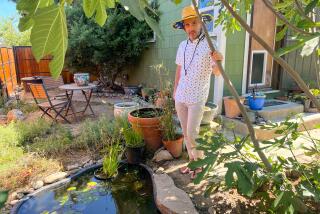THE WIZARDS OF WET : Even the Staid Take Delight in High-Tech Magic of Burbank Fountain Company
- Share via
Alan Robinson loves to tell about the tuxedoed crowd he once lured into a fountain in Dallas.
It was a hot September afternoon in 1986, the gala opening of a multimillion-dollar urban plaza. Robinson’s company, Water Entertainment Technologies, had designed several water features for the area, including a computer programmed fountain in which the water constantly, playfully changed shape.
At one point, he recalled, “The fountain turned into a pinwheel you can chase and stay dry, if you know the program. Of course I did, but everyone who followed me got soaked.”
Not that most of them minded. Robinson’s high-tech waterworks seem to invite participation, even in the stuffiest of settings.
‘Water Comes Alive’
“Water comes alive when you interact with it,” said Mark Fuller, co-creator with Robinson, of Water Entertainment Technologies in Burbank, also known as WET Enterprises. “Even in its stillest form it moves, it changes. A still pool touched by wind stops people and entertains them.”
But water is never still for very long in WET creations. It assumes wondrous shapes--a wobbly, airborne jellyfish, a glass-smooth tube lit with shifting colored light. WET fountains, such as the one in front of downtown L.A.’s Music Center, seem to bubble up out of nowhere--the water rises, thunders and vanishes, seemingly on the whim of sprites.
In pre-WET days, Fuller, 36, and Robinson, 38, designed special effects and magic fountains for Disney Productions. Together they created technology for EPCOT Center’s “Leapfrog” fountains and pop-jet water features, which fire water skyward in animated shapes.
Fuller credits his childhood surroundings in Salt Lake City with nourishing his fascination with water. “When the snow melts, water pours down the gutters,” he said. “I’d be late for school building dams and bridges.”
Robinson, another Salt Lake native, preceded Fuller through the same schools--from kindergarten to the University of Utah--before meeting Fuller at Disney. He calls his own watery preoccupation “primordial,” linking it to the thrill of natural water features such as Niagara Falls.
Once their fantasies came together at Disney, people noticed. Real estate developers who had visited EPCOT encouraged the two to start a business. In EPCOT, Fuller said, “developers saw the means to liven up a sterile bank plaza with our kind of kinetic playfulness.”
Business Has Grown
Today, more than five years up the road, WET has grown out of its first home in Fuller’s spare Studio City bedroom into a business grossing $2.5 million a year from national and international projects. In Alberta, Canada, the firm has designed and engineered a quivering, looped-water bridge and a fire-in-water fountain at one of the world’s largest indoor malls. Japan’s Seito Ohashi Exhibition near Osaka features another WET fountain, a circular grouping of fireworks-style “shooters” that blast water hundreds of feet into the air. In addition, WET has completed or started projects in U.S. cities including Minneapolis, Kansas City, Dallas, Los Angeles and the City of Industry.
Even with a staff of 31 designers, engineers, technicians and support people, Fuller said, “We’re buried most of the time. We have more work than we can handle.”
Outstanding Company
In the rarefied world of large-scale fountain design, where project costs can range from $250,000 to several million dollars, experts say WET stands out for its marriage of engineering and design.
“With patience and research, they’ve come up with pioneering things that make them in some ways the only well in town,” said Dick Chaix, senior partner of Carmel-based CMS Collaborative, a fountain engineering firm that dates to the 1940s.
Chaix, who lectures in summer classes at Harvard University’s Graduate School of Design, ranks WET among the three top fountain-designing firms worldwide and said he hopes “some of their prototypical ideas will come into wider use in the future.” Among these, Chaix named WET’s laminar flow jets--which eliminate water turbulence, thus creating a glass rod effect--and the company’s use of fiber optic lighting, which beams light along a stream of water with the sharp focus of a laser.
Unique Fountains
While WET will repeat such trademark effects, if appropriate, in different projects, each of its fountains is unique. “We have no menu or Whitman’s Sampler of water features,” says Claire Kahn, WET’s director of design.
Each site-specific design is born of brainstorming sessions between designers and engineers. “We’ll get an idea,” Kahn said. “What if water could do such-and-such? Then Alan Robinson, who directs WET’s technical development, will go away and figure out how to do it.”
WET technicians build full-scale project mock-ups in the firm’s Sun Valley test labs. Robinson said that experimentation in the lab frequently causes “happy accidents” with unexpected applications.
In such a way, a recent lab meeting involving Kahn, Robinson and Fuller brought about new lighting for a “water table” (a glass-topped fountain that flattens water spray into star-like patterns).
Sometimes the firm must turn down client requests--most commonly, Robinson said, for “the tallest fountain in the world.”
WET discourages such novelty for its own sake. “Someone can always build a taller fountain. We want our work to last as long as the architecture around it,” Fuller said.
Once a design is developed and engineered, the WET staff hands a project to contractors but visits building sites to supervise installation. The firm also offers a comprehensive maintenance program since, Robinson said, “You don’t spend enough to buy a sophisticated aircraft and then turn it over to a guy who sharpens lawn mowers.”
Looking ahead, staff members dream of seeing WET technology applied to medicine (physical therapy, for example), innovative water theme parks and water toys. Already, WET has one toy on the market, “Splatter Up,” a baseball game manufactured by Worlds of Wonder.
Drought Concerns
During this time of drought, the Music Center fountain, with its myriad jets spewing water up to 15 feet, has been criticized, Fuller said, “for just looking extravagant.”
But, like all WET features, the Music Center fountain operates with recycled water--less than a home swimming pool holds. And, Robinson added, “It gives pleasure to a lot more people.”
Lacking pedestrian barriers and operating on one of WET’s whimsical computer programs, the fountain encourages children and even tux-clad theatergoers to plunge in.
“Why not?” Robinson chuckles. “It’s the ultimate run-through-the-sprinklers experience.”
Heeger is a Woodland Hills free-lance writer.
More to Read
The biggest entertainment stories
Get our big stories about Hollywood, film, television, music, arts, culture and more right in your inbox as soon as they publish.
You may occasionally receive promotional content from the Los Angeles Times.










